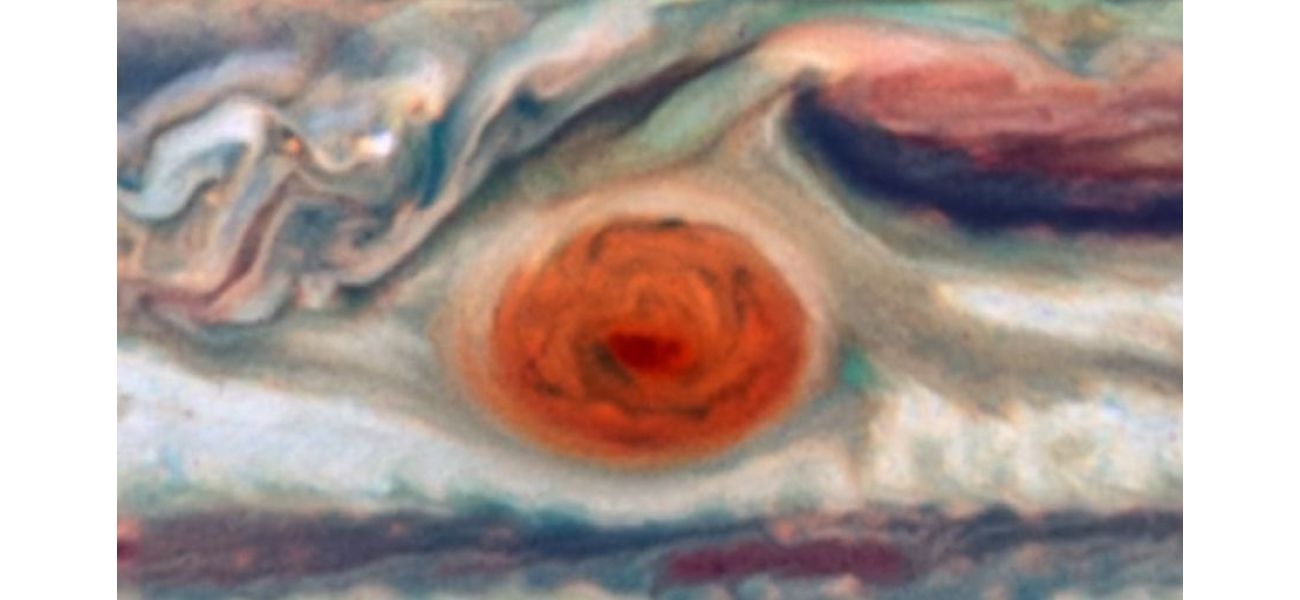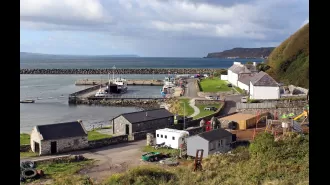A rare storm of nearly 200 years undergoes dramatic changes like a squeezed stress ball.
Hubble's recent 90-day observations revealed that the Great Red Spot isn't as stable as previously thought.
October 12th 2024.

Human-like Text:
The Hubble Space Telescope has recently captured new images of Jupiter's Great Red Spot, revealing unexpected and fascinating details about the 190-year-old storm. Astronomers were surprised to see that the storm, which has been a stable feature on Jupiter for centuries, is actually quite dynamic, wiggling like gelatin and shifting shape like a squeezed stress ball.
The Great Red Spot, also known as GRS, is an anticyclone - a large circulation of winds - in Jupiter's atmosphere. It rotates around a central area of high pressure along the planet's southern midlatitude cloud belt. This storm is so massive that Earth could easily fit inside it, making it the largest storm in our solar system. And yet, despite storms typically being considered unstable, the Great Red Spot has persisted for almost two centuries.
However, the recent observations made by the Hubble Space Telescope show that the storm is not as stable as previously thought. The changes observed in the storm seem to be related to its motion and size. In a time-lapse of the images, the vortex can be seen "jiggling" like gelatin and expanding and contracting over time. These findings were published in The Planetary Science Journal and presented at the American Astronomical Society's annual meeting.
Lead study author Amy Simon, a planetary scientist at NASA's Goddard Space Flight Center, explained, "While we knew its motion varies slightly in its longitude, we didn't expect to see the size oscillate as well. As far as we know, it's not been identified before." The high-resolution images taken by the Hubble Telescope showed the storm squeezing in and out while also moving faster and slower, which was completely unexpected.
The storm on Jupiter has been a subject of fascination for astronomers for at least 150 years, and every new observation brings new surprises. Recently, a team of astronomers used the James Webb Space Telescope to study the Great Red Spot in infrared light, revealing new details about its composition and structure. The Hubble observations, on the other hand, were taken in visible and ultraviolet light.
The team also detected the gas phosphine within the storm, which could play a role in creating the iconic red color of the Great Red Spot. "Planetary scientists have been striving for years to see patterns in this variation, anything that might give us a handle on the physics underpinning this complex system," explained study coauthor Leigh Fletcher, a professor of planetary science at the University of Leicester.
The Hubble Telescope has been tracking the storm's behavior once a year through its Outer Planet Atmospheres Legacy program. However, the recent observations were taken separately through a program dedicated to studying the Great Red Spot in more detail, allowing scientists to watch how the storm changes over a matter of months. This program, led by Simon, aims to observe the outer planets in our solar system and understand how they change over time.
The high-resolution images taken by the Hubble Telescope have provided a detailed look at the size, shape, and color changes of the Great Red Spot. "When we look closely, we see a lot of things are changing from day to day," said Simon. The changes observed included a brightening of the storm's core when it is at its largest size as it oscillates. "As it accelerates and decelerates, the GRS is pushing against the windy jet streams to the north and south of it," explained study coauthor Mike Wong.
On Neptune, similar dark spots can drift across the planet due to the lack of strong jet streams holding them in place. However, the Great Red Spot is trapped between jet streams at a southern latitude on Jupiter. Astronomers have noticed the Great Red Spot shrinking since the Outer Planet Atmospheres Legacy program began a decade ago. They predict that it will continue to shrink until it reaches a stable, less-elongated shape, which could reduce the wobble.
Fletcher concluded, "By watching the GRS over a few months, Hubble has shown that the anticyclone itself is changing its shape along with this oscillation. The shape change is important, as it may be affecting how the edge of the vortex interacts with other passing storms." These insights gathered by studying the largest storms in our solar system can also help us understand weather patterns on other planets and broaden our understanding of meteorological processes beyond just those on Earth.
The Hubble Space Telescope has recently captured new images of Jupiter's Great Red Spot, revealing unexpected and fascinating details about the 190-year-old storm. Astronomers were surprised to see that the storm, which has been a stable feature on Jupiter for centuries, is actually quite dynamic, wiggling like gelatin and shifting shape like a squeezed stress ball.
The Great Red Spot, also known as GRS, is an anticyclone - a large circulation of winds - in Jupiter's atmosphere. It rotates around a central area of high pressure along the planet's southern midlatitude cloud belt. This storm is so massive that Earth could easily fit inside it, making it the largest storm in our solar system. And yet, despite storms typically being considered unstable, the Great Red Spot has persisted for almost two centuries.
However, the recent observations made by the Hubble Space Telescope show that the storm is not as stable as previously thought. The changes observed in the storm seem to be related to its motion and size. In a time-lapse of the images, the vortex can be seen "jiggling" like gelatin and expanding and contracting over time. These findings were published in The Planetary Science Journal and presented at the American Astronomical Society's annual meeting.
Lead study author Amy Simon, a planetary scientist at NASA's Goddard Space Flight Center, explained, "While we knew its motion varies slightly in its longitude, we didn't expect to see the size oscillate as well. As far as we know, it's not been identified before." The high-resolution images taken by the Hubble Telescope showed the storm squeezing in and out while also moving faster and slower, which was completely unexpected.
The storm on Jupiter has been a subject of fascination for astronomers for at least 150 years, and every new observation brings new surprises. Recently, a team of astronomers used the James Webb Space Telescope to study the Great Red Spot in infrared light, revealing new details about its composition and structure. The Hubble observations, on the other hand, were taken in visible and ultraviolet light.
The team also detected the gas phosphine within the storm, which could play a role in creating the iconic red color of the Great Red Spot. "Planetary scientists have been striving for years to see patterns in this variation, anything that might give us a handle on the physics underpinning this complex system," explained study coauthor Leigh Fletcher, a professor of planetary science at the University of Leicester.
The Hubble Telescope has been tracking the storm's behavior once a year through its Outer Planet Atmospheres Legacy program. However, the recent observations were taken separately through a program dedicated to studying the Great Red Spot in more detail, allowing scientists to watch how the storm changes over a matter of months. This program, led by Simon, aims to observe the outer planets in our solar system and understand how they change over time.
The high-resolution images taken by the Hubble Telescope have provided a detailed look at the size, shape, and color changes of the Great Red Spot. "When we look closely, we see a lot of things are changing from day to day," said Simon. The changes observed included a brightening of the storm's core when it is at its largest size as it oscillates. "As it accelerates and decelerates, the GRS is pushing against the windy jet streams to the north and south of it," explained study coauthor Mike Wong.
On Neptune, similar dark spots can drift across the planet due to the lack of strong jet streams holding them in place. However, the Great Red Spot is trapped between jet streams at a southern latitude on Jupiter. Astronomers have noticed the Great Red Spot shrinking since the Outer Planet Atmospheres Legacy program began a decade ago. They predict that it will continue to shrink until it reaches a stable, less-elongated shape, which could reduce the wobble.
Fletcher concluded, "By watching the GRS over a few months, Hubble has shown that the anticyclone itself is changing its shape along with this oscillation. The shape change is important, as it may be affecting how the edge of the vortex interacts with other passing storms." These insights gathered by studying the largest storms in our solar system can also help us understand weather patterns on other planets and broaden our understanding of meteorological processes beyond just those on Earth.
[This article has been trending online recently and has been generated with AI. Your feed is customized.]
[Generative AI is experimental.]
0
0
Submit Comment





